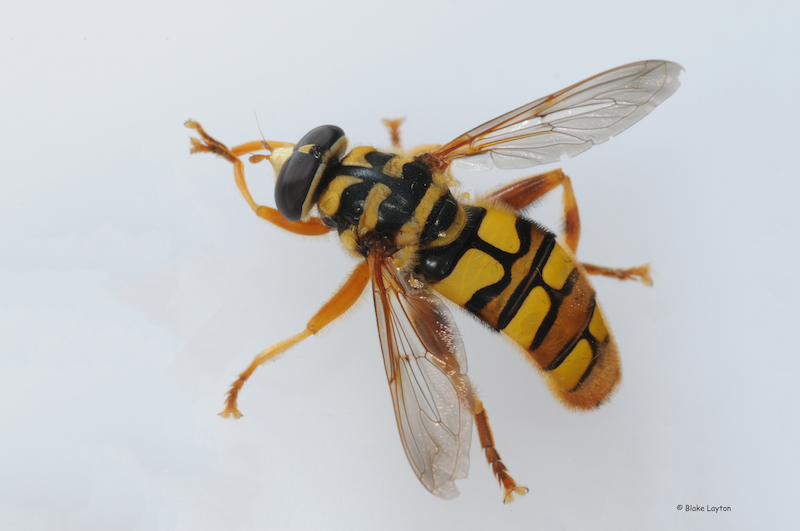Yellowjacket Hover Fly, Vol. 7, No. 20
Related News
June 17, 2015
June 4, 2015
May 19, 2015

There was a lot of excitement at the family reunion picnic last weekend. Aunt Lucy was attacked and intimidated by a large wasp-like insect that kept hovering right in front of her face. She’s allergic to bee stings, so everybody was concerned. Uncle Bud was racing to swat it with a stack of paper plates when 11-year-old Amy intervened and calmed things down. “Don’t hurt the Good News Bee Uncle Bud! It won’t hurt anybody. They bring good luck.”
Yellowjacket hover flies belong to a group of flies known as hover flies or flower flies, in the family Syrphidae. Members of this family can hover in mid-air like a hummingbird and frequently visit flowers in search of nectar and pollen. They are important pollinators.
Yellowjacket hover flies are the largest hover flies in the state. As the photo shows, they bear a strong resemblance to yellowjackets or hornets. But little Amy was right. In the South, yellowjacket hover flies are better known as “good news bees,” with the good news being that they can’t sting. Some folklore even includes the myth that they bring good luck, especially if you can get one to perch on the end of your finger. I have seen children achieve this feat on several occasions with smaller hover flies but can’t confirm whether it brought them good luck.
There are lots of species of hover flies, and most mimic bees or wasps and have the habit of hovering in midair in their search for flowers. Many species are relatively small and go largely unnoticed. Because of their large size and colorful markings yellowjacket hoverflies do get noticed, especially when they are hovering at eye level, as they often do. According to Amy, they act like they are trying to tell you something, some good news, and this is why they are called “good news bees.”
Yellowjacket hover flies are so showy and colorful that they were on a US Postal Stamp. In 1998 a sheet of 33 cent stamps featured 20 of the most colorful insects and spiders in the country, with yellowjacket hover fly being one—right there with monarch butterflies, periodical cicadas, and black widow spiders. Here's a picture of that stamp.
Hover fly larvae live in a variety of situations. Many are predators of other insects, such as aphids. A few, such as bulb flies, are plant pests. Others, such as rat-tailed maggots feed in decaying organic matter. Yellowjacket hover fly larvae develop in tree holes and other decaying wood of hardwood trees. Interestingly, many people notice or report seeing these flies when splitting firewood. Last year three different clients who inquired about identifying these flies mentioned they were cutting or splitting firewood when they saw them. Apparently, the odors of the newly split wood are attractive to female flies searching for egg-laying sites.
See Bug's Eye View No. 2 of 2021 for information on rat-tailed maggots, which are larvae of a large species of hover fly that mimics honeybees.
Blake Layton, Extension Entomology Specialist, Mississippi State University Extension Service.
The information given here is for educational purposes only. Always read and follow current label directions. Specific commercial products are mentioned as examples only and reference to specific products or trade names is made with the understanding that no discrimination is intended to other products that may also be suitable and appropriately labeled.
Mississippi State University is an equal opportunity institution.
Bug’s Eye View is now on Facebook. Join the Bug's Eye View Facebook group here.